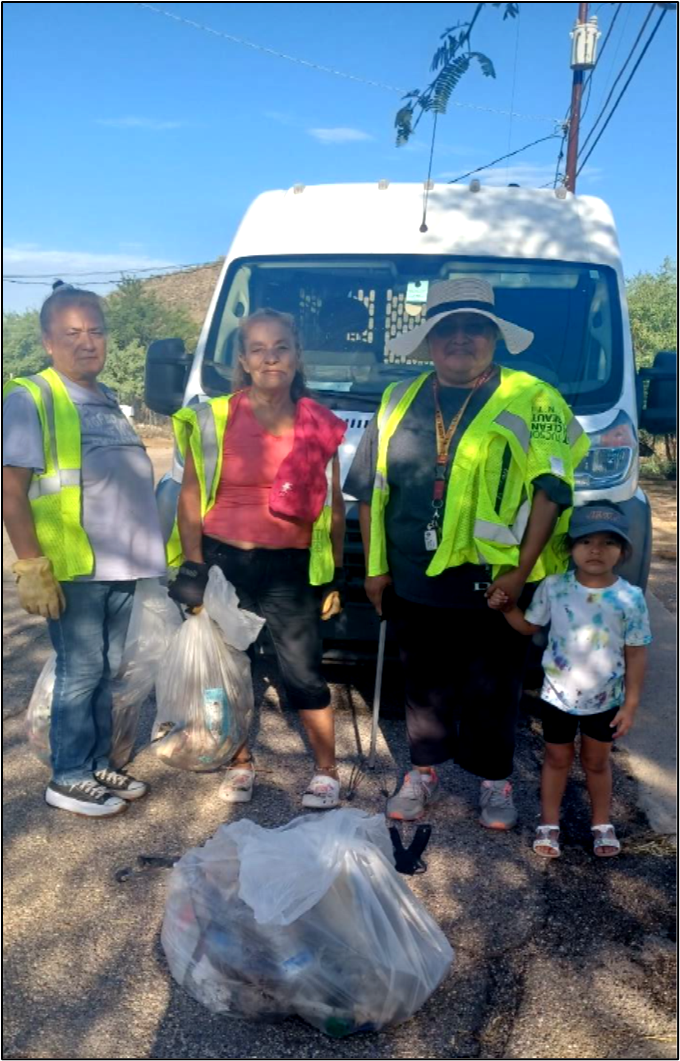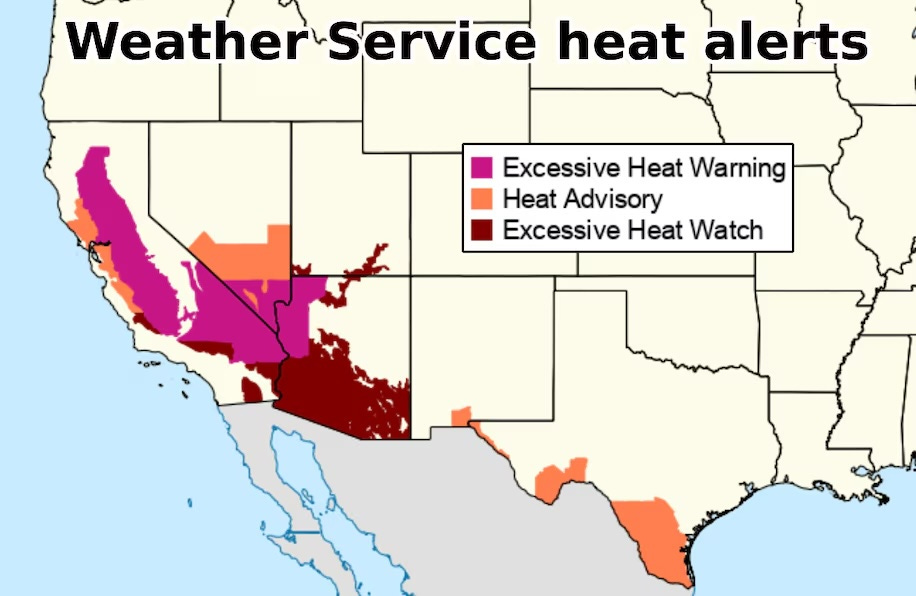Tucson City Council readies plans for protecting outdoor workers from the summer sunBy Karen Peterson, Climate Tucson “An epidemic of chronic kidney disease of unknown etiology is occurring in laborers who undertake physical work outdoors in hot conditions.” The three primary stages of traditional heat illnesses — cramps, exhaustion and stroke — are just part of the heat and health equation. The new higher heat is spawning its own heat-related diseases, notably a fatal kidney disease affecting large numbers of farm workers in Central America. Not caused by conditions normally associated with kidney disease, such as age, obesity or diabetes, this CKDu (an “unknown” chronic kidney disease) has been identified as a dangerous by-product of extreme heat combined with outdoor physical labor. Among farm workers, the mix includes pesticides. Over the past decade, the death toll from Mesoamerican nephropathy, as it’s known in Central America, increased 83% in Guatemala and it is now “the second leading cause of death in both Nicaragua and El Salvador,” according to the authors of “A New Era of Climate Medicine — Addressing Heat-Triggered Renal Disease.” In another study published by the National Institutes of Health, researchers found that “a single bout of exercise in the heat increases biomarkers of acute kidney injury.” In other words, all who labor or play hard under the sun for any length of time — or through employment — can be affected, the damage dependent on length of time spent outdoors and precautions taken, including hydration, the right clothing and rest in the shade. Research into this particular CKDu is still in the early stages, and much of the recent work has been pioneered by a PhD candidate at the University of Arizona at the time, Nicolas Lopez-Galvez. Lopez-Galvez led a study in Sonora, Mexico, that monitored farm workers at a grape-growing operation not far from the Arizona border. Published in 2021, as hypothesized the study found that heat stress and dehydration were contributing factors for developing kidney disease. Continuing through the harvest season, results showed that while all those studied had normal kidney functioning at the beginning of season, as the grape harvest continued over several months the workers “experienced a significant decline in kidney function.” By late harvest, one worker had developed kidney disease, two “experienced a kidney injury” and 12 showed signs of kidney distress. (Participants, average age 28.5, numbered 151 in the beginning, with 56 dropping out before the end of the harvest. Half were indoor workers for the company; the others were farm workers. “No significant change in kidney function was observed in office workers,” according to the study.) Heat Ordinances, Heat Roadmap on the June 4 Tucson City Council Agenda Research to date poses the very real question of how we should proceed in efforts to protect ourselves and others from emerging heat-related diseases, which the authors of “A New Era of Climate Medicine” caution “will be unmasked and accelerated by climate change.” The answer right now, as the heat tracks higher globally and also in Tucson — we’re under our first “excessive heat watch” warning of the season later this week — is to act on what we know and begin to protect the people most affected: outdoor workers of all ilk, postal to field to construction and solar installations. Joining Phoenix and the State of Arizona in their efforts to protect outdoor workers, the Tucson City Council at its meeting tomorrow, June 4, will vote on an ordinance to require excessive heat protections for outdoor contract workers and the adoption of the City’s Heat Action Roadmap. The roadmap contains strategies and actions and represents the procedural extension of the Climate Action and Adaption Plan (CAAP) completed this year. According to Fatima Luna, the City’s chief resilience officer, the roadmap was “inspired by the valuable discussions and ideas” shared by community members at the Southern Arizona Heat Summit this past February. Discussion of the roadmap is scheduled during the 1 p.m. council study session. Following the final vote on the City’s 2024-2025 budget at the regular 5:30 meeting, the council will hear Ordinance No. 12100 developed by the City’s Climate Action Team. The ordinance requires that any business doing business with the city must “utilize heat-hazard mitigation plans to prevent heat-related illness and injuries in the workplace” for those who work outdoors. Additionally, the Climate Action Team developed a Heat Protection Administrative Directive (AD) for City workers with protections similar to the ordinance. ADs do not require mayor and council approval. |
Sunday, July 21, 2024
Climate Tucson: New Heat, New Diseases
Friday, July 19, 2024
Storm to Shade Across Tucson
by Blue Baldwin, Storm to Shade Program Manager
In the cool early hours of a midsummer morning in Barrio Kroger-Lane, long-time resident and community organizer, Josefina Cardenas, prepared breakfast burritos to share with her neighbors to fuel their morning’s work. With the support and expertise of Tucson Clean and Beautiful’s green stormwater infrastructure (GSI) maintenance team, Josefina and her neighbors took to their neighborhood streets to care for the GSI assets built there over the past decade. As they pulled weeds, collected trash, and spread native seed mix, nanas and tatas worked alongside younger generations, sharing their knowledge of desert plants and their healing properties and memories of the nearby river that once flowed perennially.
Tucson Clean and Beautiful is one of six maintenance contractors deployed seasonally by Storm to Shade (S2S), the City of Tucson’s GSI program housed at Tucson Water, to ensure the safety and functionality of some 450 GSI assets located throughout the City’s six wards. This cohort of specialized contractors provides routine maintenance as well as certified arborist services, invasive plant control, reconstruction of assets, community outreach, and stipends to pay community members who wish to be involved in caring for their neighborhoods’ assets. With this workforce in full effect for almost two years, Tucson’s GSI is thriving—providing shade, cooling, habitat, and beautification—thanks to the energy and resources being invested in our City’s urban infrastructure. To view a map of GSI assets throughout the City, see https://climateaction.tucsonaz.gov/pages/s2s-about.
In another neighborhood, over a dozen children and a handful of adults gathered at the intersection of Holladay Street and Santa Clara Avenue in the Elvira Neighborhood to celebrate the completion of a brand new GSI project with Eegee’s and a native plant give-away. Among them was Beki Quintero, a lifelong servant of the Tucson community. For years Beki had advocated to decrease the size of this awkward and potentially dangerous intersection situated in a neighborhood teeming with kids. When Ward One’s Budget de la Gente Program launched, this project was selected for funding and Beki and her neighbors’ dream was finally realized. To minimize project costs, S2S collaborated with the Department of Transportation and Mobility’s special projects team to accomplish much of the work in-house--removing pavement, excavating basins, and re-striping the intersection. S2S contracted local GSI experts, Productive Patches LLC, to add the finishing touches--microbasins and swales--and a landscape contractor to plant native trees, shrubs, and succulents. These days if you drive by after school, you’re likely to spot a gaggle of neighborhood kids hanging out near their new green space.
 |
| Intergenerational stewards of Barrio Kroger-Lane celebrate work well done. |
To date, Storm to Shade has constructed six new GSI projects, most recently at Ironhorse Park, El Rio Neighborhood Center, Lower Lincoln Park, the intersection of 11 Ave. and Flores St., and the traffic triangle at Holladay St. and Santa Clara Ave. The Aviation Greenway between Kolb and Calle Polar, a collaboration with TEP, will be complete July ’24 and an additional handful of projects are set to break ground by year’s end. Many more are in the design pipeline. For a complete list and story map of projects, visit https://climateaction.tucsonaz.gov/pages/gsi
S2S is also celebrating the completion of several large-scale projects funded by Pima County Regional Flood Control District, which serve primarily as flood control facilities but also provide the greening, cooling, and beautification benefits of GSI. S2S provides landscape maintenance for these facilities, which include Cherry Avenue Park, El Vado Basin, Sunland Vista Wash, and soon-to-be-completed Alvernon Park Basins, as well as several others constructed by the District over the past years.
In the shade of the mature mesquites in the GSI area of Highland Vista Park, a dozen participants in the Pima SmartScape GSI course practice proper pruning techniques under the exacting eye of certified arborist, GSI expert, and SmartScape instructor Emma Stahl-Wert. The group consists of S2S maintenance contractors, a newly minted City Parks project manager, and other landscape pros and community members interested in expanding their knowledge of GSI. This GSI course is one of three new courses offered by SmartScape (funded by Tucson Water’s Conservation Program) developed in partnership with City of Tucson. The others are a one-day SmartScape “Bootcamp” designed as a crash course in best practices for landscape maintenance, and an Urban Forestry Management course. The goal is for every City employee who touches landscape to complete all three courses. This investment in staff significantly reduces unintended damage to landscapes, boosts morale, and creates a ripple effect as folks transfer knowledge among their peers in the field.
 |
| Emma guides SmartScape participants through proper pruning technique. |
Looking forward, S2S hopes to better align with the City’s equity goals by evaluating new models for prioritizing capital investment that center equity as the primary driver for investment rather than equality. Currently, S2S capital investments are divided equally across the six wards and the Mayor’s Office. Given vastly different demographics, green space, and climate vulnerability across the wards, equal investment is not equitable investment. Tucson is not alone in grappling with this issue. The conversation around GSI and equity is happening at fever pitch across municipalities and utilities in North America and is the central theme of myriad conferences, webinars, and publications. S2S, the Urban Forestry Program, and other Tucson programs’ use of Tree Equity Score as a tool for prioritizing investment within wards has positioned us a leader among our peers in North America, and we are excited to continue to lead by making S2S a truly equity-driven program.
 |
| path to Tree Equity |
-reshared from the City of Tucson Climate Action Report
Sunday, July 7, 2024
Celebrating the start of purslane season
Next I rinse them off 3 or 4 times. The little black seeds fall to the bottom of the bowl. I pour the seeds and water where I want some more purslane to grow.
 |
 |
| Dan likes a lot of green chili sauce |
You can find that recipe and another favorite recipe here.











